Reshaping Slussen in Stockholm – goodbye cars, hello people
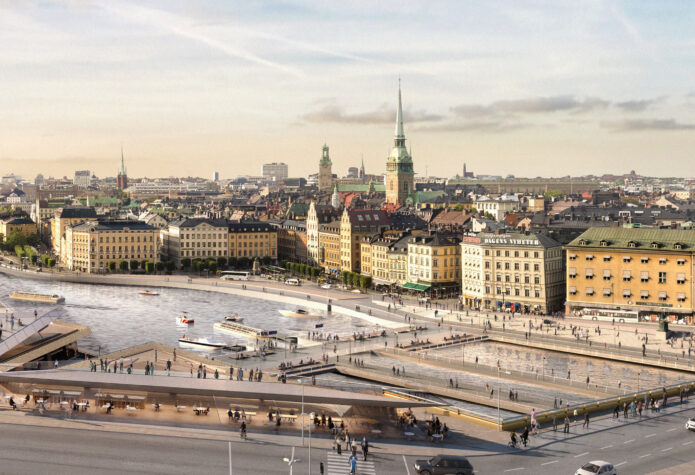
If you have visited downtown Stockholm lately, you might have noticed that there is a giant hole in the city, stretching all the way from the cobbled streets of the Old Town to the trendy residential area of Södermalm. This is one of the biggest ongoing construction projects in Sweden: the New Slussen, where one of the city’s main traffic hubs is being reshaped into a modern, people-friendly centre. NIB is one of the project financiers.
“The old Slussen had come to the end of an era”, says Lisa Jacobsson, Deputy Project Director for Slussen development at City of Stockholm. “After almost 80 years of use, it was in poor condition and needed to be rebuilt from scratch.”
Ms Jacobsson invites the visiting NIB team to enjoy a bird’s-eye view of the enormous building site, as we are standing at the famous Katarina terrace almost 40 metres from the ground. Although Stockholm has wrapped itself in a deep November fog this morning, the city skyline with rooftops and church towers looks impressive against the grey horizon. In the construction site far beneath us, construction workers and vehicles in yellow, red and green are moving around as bright spots against the dark soil.
Where people and boats meet
When the major traffic hub Slussen—named after the water lock between Lake Mälaren and the Baltic Sea—opened in its current form in the 1930s, cars were admired as the future of transportation. Any respectable and modern city were to cater mainly for them, and accordingly, for almost 80 years the area has been dominated by a big knot of road junctions, linking Stockholm’s Old Town and commercial centres with the city’s southern, residential parts.
“Hundreds of thousands of commuters pass through here every day”, Ms Jacobsson continues. “Our aim is for this to become one of Stockholm’s most attractive places to meet, with market squares and a new city park. For example at the new Slusstorget (the Water Plaza)—where the water lock will be in the centre—visitors can take a break, have a coffee, enjoy the sunshine and watch the boats passing through the lock.”
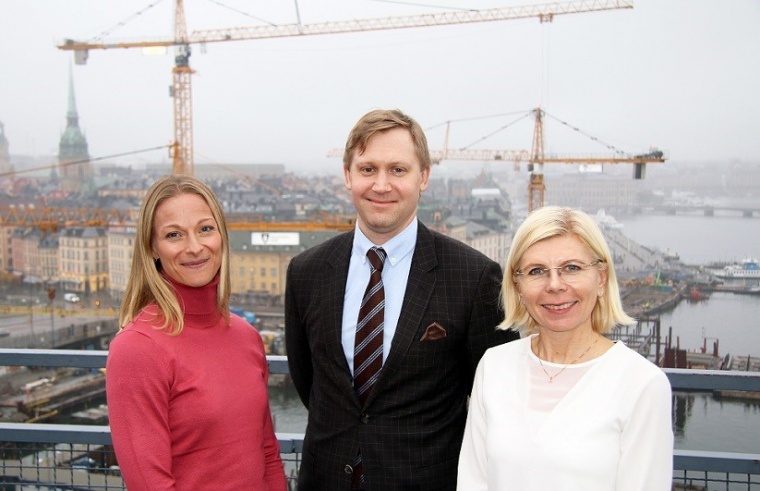 In front of the Slussen construction site. From left: Lisa Jacobsson, Deputy Project Director at City of Stockholm; Patrik Marckert, Senior Manager at NIB and Sofie Nilvall, CFO at City of Stockholm. Photo: Pamela Schönberg.
In front of the Slussen construction site. From left: Lisa Jacobsson, Deputy Project Director at City of Stockholm; Patrik Marckert, Senior Manager at NIB and Sofie Nilvall, CFO at City of Stockholm. Photo: Pamela Schönberg.
The new Katarina city park and the market squares are not likely to remain empty, as Stockholm is expecting 40,000 more residents every year, meaning that more than one million people will be living in the core of the city by 2030.
“Our city is growing fast, and besides new housing and workplaces, we need new meeting places and better public communications”, Ms Jacobsson explains. “NIB’s financing will, among other things, fund the construction of a new bicycle and pedestrian bridge, which will contribute to a reduced focus on cars. This is in line with the goals in the city’s environmental programme, as we expect the number of cyclists and pedestrians to double in the next ten years.”
The threat of rising water
In addition to Slussen being a major intersection for buses and the Stockholm metro, it also hosts a canal, which is an important link for boats heading from Lake Mälaren to the Baltic Sea. The first lock was built here already in 1642, as the level differences between the lake and the sea made it difficult to travel through the canal.
Since then, the lock has been replaced many times, and besides helping boats steer safely to the sea, it has an important task: to control the water level of Lake Mälaren. The lake is today the source of drinking water for two million people, and is as such under special protection when it comes to the quality of water. Ms Jacobsson points out that living in a city built on fourteen islands does come with some challenges.
“The risk of flooding threatening the area around the lake is high, and we must be able to release more water in order to regulate the levels. Currently, it is not possible to drain enough at times when vast quantities of water are flowing into the lake, for example during the spring thaw. But the new and larger Slussen canal will eliminate the risks and safeguard access to drinking water. At the same time, vulnerable areas such as the underground station at Gamla Stan, Västerås Airport and other important infrastructure and buildings will be protected.”
The New Slussen is built to last around 100 years, and is designed to reduce today’s threat of flooding, as well as to handle the expected increase in sea levels caused by climate change further on.
The first suburb in Sweden
The construction work started in 2016, and has since then dug deep into the city soil. From where we stand on the terrace, we can clearly see the 250-year-old ruins and structures of streets and house walls that have recently been revealed from beneath the ground. Slussen’s history of human habitation dates as far back as the Vikings, so archaeological considerations are also at the top of the agenda when planning the project.
“We always have an archaeologist on site monitoring the work to detect findings that may be of interest”, says Ms Jacobsson. “When something is found, the work immediately stops and an excavation is performed. The archaeologists meet regularly with representatives of the city and the contractor to plan and schedule the work. This project has led to a great deal of valuable findings that in some cases have altered how we understand the history of Stockholm. As this was the very first settlement outside the original city walls in the old town, you could even say that Slussen was the first suburb in Sweden!”
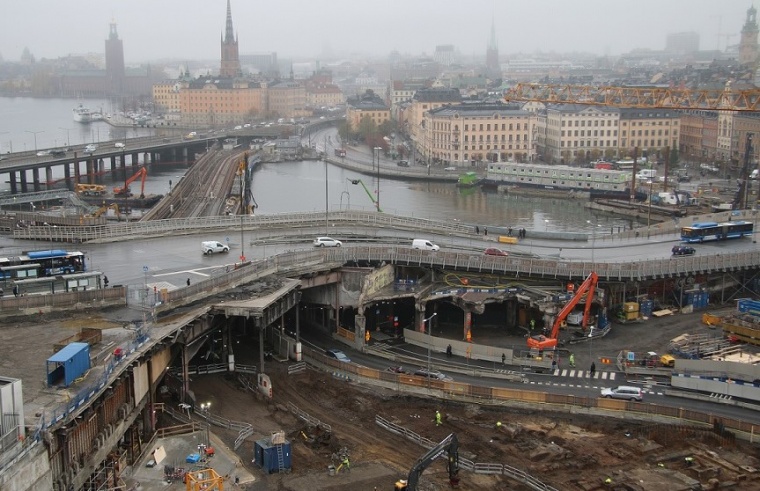 The New Slussen construction site in November 2018. Archeological excavations are ongoing in parallel. Photo: Pamela Schönberg.
The New Slussen construction site in November 2018. Archeological excavations are ongoing in parallel. Photo: Pamela Schönberg.
“But we are of course also considering the current Stockholmers”, she continues. “The building work is expected to continue until 2025, and during this time, we are offering people living and working in the area different solutions to reduce noise and disturbances, for example by reinforcing windows or even finding them alternative accommodation, if needed. Furthermore, extensive communication regarding the progress of the work has had a positive impact. We are prioritizing keeping the area clean and safe.”
Regarding public opinion of the New Slussen, Ms Jacobsson says that it is now positive, although the project initially generated intense debate, as certain groups and organisations wanted to preserve the old structure of the area.
“A number of surveys have been conducted since the start of the project. They show that a majority of citizens have a positive attitude towards the New Slussen, so there is now a consensus that the final solution will meet the expectations of the public.”
NIB a proud partner
NIB’s part of the project financing is SEK 500 million, corresponding to about EUR 48 million. As well as the 200-metre bridge for cyclists and pedestrians, the loan also provides for the new flooding lock, a new entrance to the metro station and an improved quay for the Skeppsbron ferries. Patrik Marckert, Senior Manager at NIB, looks happy watching the ongoing work at the building site below us.
“NIB is very proud to be a partner in this project”, he says. “Apart from us taking part in shaping the future of Stockholm, the development of Slussen is important for many infrastructural and environmental reasons. Consequently, this loan is to be 100% funded with proceeds from NIB’s environmental bonds.”
Ms Jacobsson adds that NIB and Stockholm have a long history of good projects together.
“NIB is a financing partner in a number of projects within the city of Stockholm. Due to its financial robustness, the Bank can offer attractive interest rate conditions and is a valued partner for us”, she declares, before we head to the elevator taking us back to the ground. When the New Slussen is ready, we will definitely be back to enjoy coffee, sunshine and boats at the new Water Plaza.
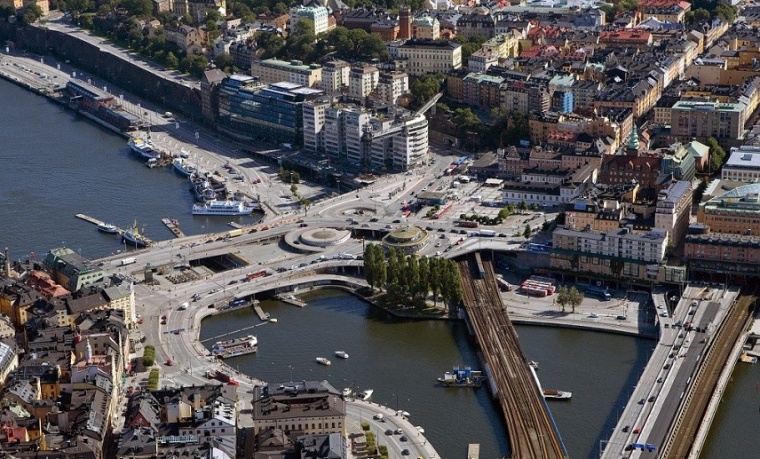 Before: the old Slussen with its characteristic road junctions and narrow canal for boats and water drainage. Photo: Lennart Johansson, 2009.
Before: the old Slussen with its characteristic road junctions and narrow canal for boats and water drainage. Photo: Lennart Johansson, 2009.
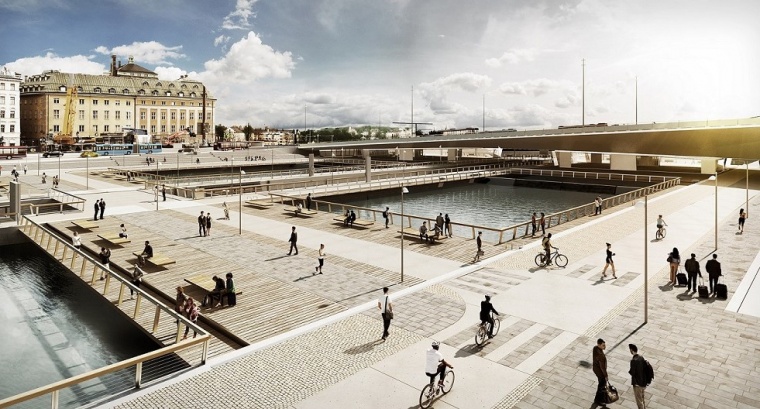 After: The New Slussen with more space for pedestrians and cyclists, and a canal with five times larger drainage capacity. Illustration: White Arkitekter.
After: The New Slussen with more space for pedestrians and cyclists, and a canal with five times larger drainage capacity. Illustration: White Arkitekter.

